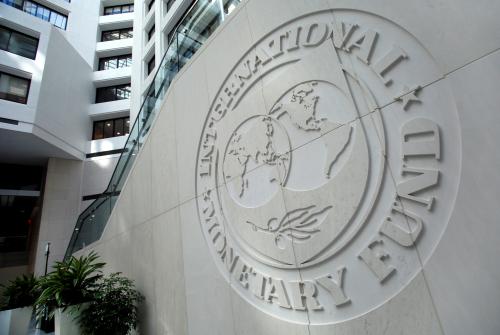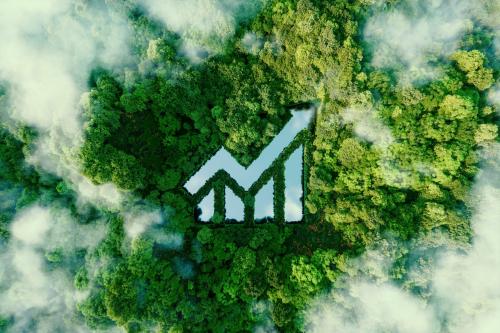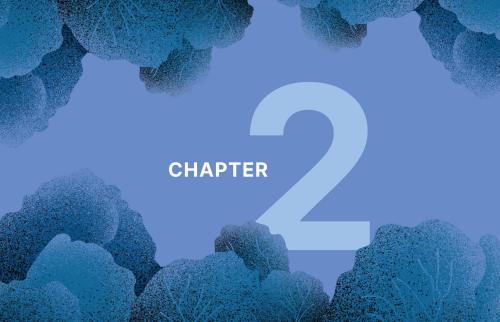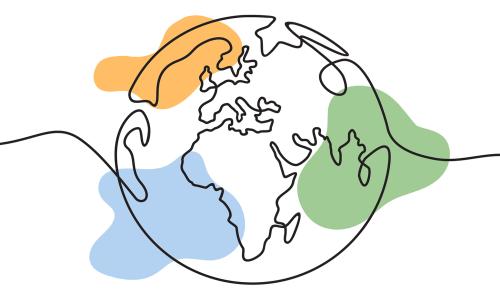Executive summary
Entering 2024, multiple forums are debating reforms to the international financial architecture to resolve developing country debt problems. These forums should start by identifying the different problems that need to be solved. In this paper, we argue that there are four distinct debt-related questions that developing countries are confronting, each of which merits its own response: (i) how to meet current debt service obligations; (ii) how to open fiscal space for debt-financed sustainable infrastructure and other priority development investments; (iii) how to best use debt in responding to natural disasters; and (iv) how to improve debt transparency to better the overall functioning of global capital markets.
Problem 1: How to meet current debt service obligations
In 2020, the nominal dollar value of developing country exports fell by almost 10%, just at the time when external debt service was rising and when global capital was rushing to advanced country safe havens. Developing countries owed 10% of total GDP in external debt service.1
A G20-led Debt Service Suspension Initiative (DSSI) helped alleviate the liquidity problem in the lowest-income countries. Surges in lending from the International Monetary Fund (IMF) and multilateral development banks also helped.
In 2022, central banks in the major advanced economies started to raise interest rates, with significant impact on interest payments owed by developing countries in 2023. Meanwhile, the DSSI had expired, and net financial transfers from official multilateral agencies declined steeply in 2023. No International Development Association (IDA)-eligible country was able or willing to issue a bond on global capital markets in 2023. Many countries faced severe shortages of foreign exchange.
At the start of 2023, officials at the IMF, World Bank, and U.N. had warned that 60% of low-income countries were either in, or at high risk of, debt distress.2 This triggered calls for systemic change to streamline the G20 Common Framework for Debt Treatments into a speedy, efficient mechanism for debt resolution that could also be applied to middle-income countries.
During 2023, only Ghana applied for relief under the Common Framework auspices. Nevertheless, the feared systemic spread of debt crises did not materialize. Most developing countries were able to muddle through and meet their external payment obligations, albeit at considerable cost of cutting needed social programs and investments. Ethiopia was the only developing country to default in 2023, missing a late December bond payment.
Total debt service due in 2024 is now estimated to be lower in sub-Saharan Africa and the Middle East regions, while exports are rising.3 From 2025 and onward, debt servicing should be manageable in most cases without resorting to exceptional measures, such as blanket debt relief. It is important for developing countries to retain hard-won access to global capital markets.
Two lessons should be learned from the experience of the past few years. First, reliance on private sector financing carries high liquidity risks, complicates reprofiling of debt service, and so cannot easily substitute for official financing. Second, private lenders have been shielded from the consequences of their overlending. There is moral hazard in global capital markets that now needs to be rolled back.
The Common Framework should have a separate window, open to all countries, that is limited to a debt reprofiling exercise, with haircuts taken off the table. This window will need new money packages or restructurings from official creditors, conditioned on priority investments but with reduced structural conditionalities.
Problem 2: How to open fiscal space for debt-financed sustainable infrastructure
Emerging economies in sub-Saharan Africa, Latin America, and developing Europe have investment rates that average between 20-22% of GDP.4 These rates are lower than in 2015 when the international community agreed to pursue ambitious sustainable development goals and to refresh the global framework for development financing.5 Since Addis, the need for higher investment and more financing in emerging economies has risen, to meet commitments to invest more in global public goods and challenges: climate action, pandemic surveillance, and nature preservation.
President Ruto of Kenya, along with other leaders, has called for a new energy pact for Africa to finance and realize energy projects, while tackling governance, environmental and labor issues.6 The problem is that many governments lack fiscal space and cannot access new project finance due to the overhang from existing debt.
When countries have high debt, policymakers face a dilemma: cut back spending to reduce the rate of debt accumulation or accelerate investment in high-return projects to grow out of debt problems. At present, creditors tend to favor the former while borrowers argue for the latter. The empirical evidence as to which strategy better averts debt problems is mixed and heavily dependent on context and time.7 In contrast, the empirical evidence on which strategy is needed to better address climate change and sustainable development is strong: a big push on investment.8
A big push investment strategy should be effective in most developing countries. The World Bank estimates its projects have had a median ex post 17% rate of return in developing countries of all types—middle-income and low-income, and in every geography.9 It has documented “200 windfall-producing investment booms—episodes in which per-capita investment growth accelerated to 4 percent or more and stayed there for more than six years” as periods of income growth, higher productivity, and reduced poverty.10 Such evidence corroborates modeling simulations done by the IMF that find a large public investment push would be beneficial for borrower governments and their populations, as well as for new and existing creditors.
Such microeconomic evidence on high rates of return to public investment is treated with skepticism in some quarters because of the possibility of selection bias, or the difficulties of scaling up in the face of possible Dutch Disease and adverse macroeconomic effects of high investment.
A mindset change is needed for such evidence to be taken seriously. The presumption that public sector debt insolvency reflects economic mismanagement, waste, and corruption needs to be overcome. Historical evidence suggests that wars and revolutions are more frequent causes of insolvency than economic mismanagement.11
For those who view debt as unsustainable because of wasteful spending in the past, a solution may lie in debt write-offs. This can, in principle, resolve the debt problem. It is unlikely, however, to resolve the problem of inadequate investment and growth. For this, new money is needed, and a bad track record will reduce access to funds.
Hence, we suggest an alternative strategy to manage the debt overhang. Let multilateral development banks (MDBs) lend more for specific public and private investment programs.12 MDBs enjoy preferred creditor treatment and have a proven track record of high returns on the development projects they finance. They also provide additional benefits in the form of policy advice, project origination, and long-term affordable loans. MDBs can coordinate a bridge between new money, investment, and policy reform, along the lines suggested by President Ruto and by academics.13
MDB lending to support country platforms should be the initial entry point for their scale-up. Figuring out how to expand the quantity of high-quality projects and enhance design and implementation capability is not a simple matter. Country-owned and country-led transformation platforms are novel institutional mechanisms to do this. These have been piloted in energy transition and other sector programs that seek to achieve specific results over a specified time period.
Country platforms also provide a mechanism for partnering with private creditors. Ultimately new private creditors will only participate at scale if they are able to reduce their risk, either implicitly via a “halo” effect from engagement with MDBs or explicitly through a guarantee from a AAA-rated entity such as an MDB.
To encourage private sector activities in non-investment grade developing countries, finance for green investments in designated country platforms should be treated in the same way as trade finance and exempted from future negotiations on debt rescheduling. The added advantage of reducing risk in this way for global-priority investments is that the interest rate that commercial banks charge on green infrastructure projects would also be driven down, raising financial returns.
Of course, this approach should be implemented in a measured and selective way to keep the level of senior debt manageable and to strengthen fiscal solvency over time. New tools and mechanisms to assess public solvency in a nuanced fashion are needed. The MDBs should modernize their debt sustainability assessments (DSAs) to focus on public solvency, leaving the assessment of liquidity and rollover risk to the IMF. There are useful programs for international technical assistance to strengthen public debt management and these could be given greater priority. Official creditors could also support the establishment of independent fiscal councils and public net worth accounting in developing countries, both of which could provide better controls on the appropriate level of public investment than the debt and debt service ratio threshold criteria embedded in DSAs and other MDB creditworthiness assessments.
Problem 3: How to best use debt in responding to natural disasters
When developing countries are hit by natural disasters, they borrow to cushion the effect of the shock. This is a sound use of borrowing capacity, but it has its limits. When there is a sequence of natural disasters destroying capital that then needs to be rebuilt before being destroyed by the next disaster, borrowing becomes ineffective. Debt simply mounts, while domestic assets do not grow. Many Caribbean countries have fallen victim to this cycle. The IMF estimates that the cost to the Caribbean from natural disasters has averaged 2.4% of GDP each year between 1980-2020.14 One in ten disasters causes damage and loss of more than 30% of GDP in small countries.15
There are now 68 member states in the V20 group of vulnerable countries faced with the risk of a cycle of disaster-rebuild-repeat, or a single disaster that is very large compared to the economy.
Debt relief can help in these cases, but it is the second-best solution. Seychelles and Belize restructured their debts after major catastrophes. Grenada and Barbados have pioneered automatic disaster-relief clauses in their debt contracts. Such clauses should become standard practice in new bond contracts. The International Credit Market Association has developed appropriate standardized contracts that can be used in private debt contracts. Similarly, the World Bank has expanded its climate-resilient debt clauses for selected borrowers. Other official lenders should follow suit.
A preferred solution is more and better insurance but the insurance gap in developing countries remains enormous. According to SwissRe, 60% of global insurable crop production was unprotected against natural disasters and accidents, and 76% of global exposure to catastrophes was unprotected.16
Catastrophe bonds are now available for individual countries. However, premiums can be exorbitant, and the preexisting condition of a country’s geography can create a market failure. In such situations, it would be just and equitable for the international community to bear a portion of the underlying risks by subsidizing insurance premiums through donor-funded mechanisms like the Global Risk Financing Facility. The newly established loss and damage fund also directly provides subsidies to countries hit by natural disasters and could potentially be used to buy down insurance premiums. But these and other examples of subsidized insurance facilities must be adequately resourced to be impactful at scale.
Problem 4: How to improve debt transparency
Without debt transparency, global credit markets cannot work efficiently. Risk rises and with it the cost of capital to developing countries. Aggregate credit limits, used by lenders to limit moral hazard and adverse selection, only work if data is reliable, up-to-date, and verifiable.
Only one IDA-eligible country, Burkina Faso, has been judged as fully transparent in its debt reporting. A raft of initiatives to improve reporting is ongoing, in the IMF, World Bank, and the Organisation for Economic Cooperation and Development (OECD). However, there is little evidence of progress, and incomplete information complicates and lengthens debt negotiations, as exemplified by the Zambia case. Efforts to encourage countries receiving debt relief under the debt service suspension initiative to improve their reporting have so far been unsuccessful.
Elevating the priority of debt transparency is a prerequisite to any sustainable treatment of developing country debt. An institutional strengthening component for debt reporting should be included in all debt relief packages.
-
Footnotes
- International Monetary Fund. “World Economic Outlook: Navigating Global Divergences.” International Monetary Fund. October, 2023. https://www.imf.org/en/Publications/WEO/Issues/2023/10/10/world-economic-outlook-october-2023
- Georgieva, Kristalina. “Confronting Fragmentation Where It Matters Most: Trade, Debt, and Climate Action.” International Monetary Fund. January 16, 2023. https://www.imf.org/en/Blogs/Articles/2023/01/16/Confronting-fragmentation-where-it-matters-most-trade-debt-and-climate-action
- International Monetary Fund. “World Economic Outlook.” October, 2023.
- International Monetary Fund. “World Economic Outlook.” October, 2023.
- United Nations. “Addis Ababa Action Agenda of the Third International Conference on Financing for Development.” July, 2015. https://sustainabledevelopment.un.org/content/documents/2051AAAA_Outcome.pdf
- Ruto, William and Fatih Birol. “A New Energy Pact for Africa.” July 12, 2023. https://www.project-syndicate.org/commentary/new-energy-pact-for-africa-will-create-prosperous-future-by-william-ruto-and-fatih-birol-2023-07
- International Monetary Fund. “World Economic Outlook.” October, 2023.
- Bhattacharya, Amar, Meagan Dooley, Homi Kharas, Charlotte Taylor, and Nicholas Stern. “Financing a big investment push in emerging markets and developing economies for sustainable, resilient and inclusive recovery and growth.” London School of Economics and Political Science. May 23, 2022. https://www.lse.ac.uk/granthaminstitute/publication/financing-a-big-investment-push-in-emerging-markets-and-developing-economies/
- World Bank Group Finances. “IEG World Bank Project Performance Ratings – Archived.” World Bank Group. March 31, 2022. https://finances.worldbank.org/Other/IEG-World-Bank-Project-Performance-Ratings-Archive/rq9d-pctf/about_data
- World Bank. “Global Economic Prospects – January 2024, Chapter 3: The Magic of Investment Accelerations.” The World Bank. January, 2024. https://thedocs.worldbank.org/en/doc/661f109500bf58fa36a4a46eeace6786-0050012024/original/GEP-Jan-2024.pdf
- Von Luckner, Clemens Graf, Josefin Meyer, Carmen M. Reinhart, and Christopher Trebesch. “Sovereign Debt: 200 years of creditor losses.” International Monetary Fund. November, 2023. https://www.imf.org/-/media/Files/News/Seminars/2023/ARC/session-4-discussant-paul-schmelzing.ashx
- The Independent Expert Group on Strengthening Multilateral Development Banks. “The Triple Agenda: A Roadmap for Better, Bolder, and Bigger MDBs, Volumes 1 and 2.” G20 2023 India. October 13, 2023. https://www.g20.in/content/dam/gtwenty/gtwenty_new/document/Cover%20with%20Inside%20page%204%20oct.pdf
- Diwan, Ishac, Vera Songwe, and Martin Kessler. “A Bridge to Climate Action.” Finance for Development Lab. May 1, 2024. https://findevlab.org/a-bridge-to-climate-action/
- International Monetary Fund. “Caribbean Climate Crisis Demands Urgent Action by Governments and Investors.” June 27, 2023. https://www.imf.org/en/Blogs/Articles/2023/06/27/caribbean-climate-crisis-demands-urgent-action-by-governments-and-investors
- International Monetary Fund. “Building Resilience in Developing Countries Vulnerable to Large Natural Disasters,” Policy Paper No. 2019/020. June 26, 2019. https://www.imf.org/en/Publications/Policy-Papers/Issues/2019/06/24/Building-Resilience-in-Developing-Countries-Vulnerable-to-Large-Natural-Disasters-47020
- Xing, Li and Roopali Aggarwal. “Crop insurance: offering a way to support food security.” SwissRe. September 20, 2023. https://www.swissre.com/institute/research/sigma-research/Economic-Insights/crop-insurance.html









